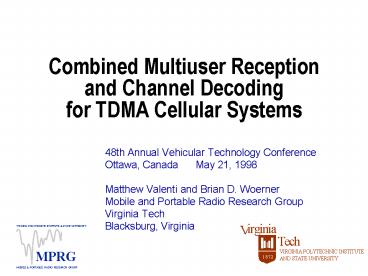Combined Multiuser Reception and Channel Decoding for TDMA Cellular Systems
Title:
Combined Multiuser Reception and Channel Decoding for TDMA Cellular Systems
Description:
Title: The Turbo Decoding Principle Tutorial Introduction and State of the Art Author: Matthew Valenti Last modified by: Matthew Valenti Created Date –
Number of Views:156
Avg rating:3.0/5.0
Title: Combined Multiuser Reception and Channel Decoding for TDMA Cellular Systems
1
Combined Multiuser Receptionand Channel
Decodingfor TDMA Cellular Systems
- 48th Annual Vehicular Technology Conference
- Ottawa, Canada May 21, 1998
- Matthew Valenti and Brian D. Woerner
- Mobile and Portable Radio Research Group
- Virginia Tech
- Blacksburg, Virginia
2
Introduction
- Performance of multiple access systems can be
improved by multiuser detection (MUD). - Verdu, Trans. Info. Theory 86.
- Viterbi algorithm, complexity O(2K).
- MUD for CDMA systems.
- Jointly detect signals from the same cell.
- Optimal MUD is too complex for large K.
- MUD for TDMA systems.
- Jointly detect signal from within the cell plus
one or two strong interferers from other cells.
3
MUD for Coded TDMA
- TDMA systems use error correction coding.
- Soft-decision decoding outperforms hard-decision
decoding (2-2.5dB). - However, the optimal MUD passes hard-decisions to
the channel decoder! - Dont use optimal MUD if loss due to
hard-decision decoding is greater than gain due
to multiuser detection. - Alternatively, the interface between MUD and
channel decoder could be improved.
4
Outline of Talk
- System Model.
- bit asynchronous.
- Generalized for both TDMA and CDMA.
- MUD for TDMA.
- Proposed Receiver Architecture.
- Turbo processing.
- Simulation results
- RSC coded system.
- 1 strong interferer.
- SOVA decoders.
5
System Model
- Received Signal
- For TDMA
- Matched Filter Output
6
Optimal Multiuser Detection
- Place y and b into vectors
- Compute cross-correlation matrix
- For the TDMA case the above reduces to
7
Optimal MUD (Continued)
- Run Viterbi algorithm with branch metric
- where
- Note that the p(b) term is usually dropped.
- The channel decoder will provide this value.
- The algorithm produces hard bit decisions.
- Not suitable for soft-decision channel decoding.
8
Soft-Output MUD
- Several algorithms can be used to produce
soft-output. - Trellis-based.
- MAP algorithm
- Log-MAP, Robertson et al, ICC 95
- OSOME, Hafeez Stark, VTC 97
- SOVA algorithm
- Hagenauer Hoeher, Globecom 89
- Non-trellis-based.
- Suboptimal, reduced complexity.
9
Proposed System Architecture
Interleaver
SISO Multiuser Detector
Deinterleaver
SISO Channel Decoders
Matched Filters
Deinterleaver
Channel Estimator
- Each user interleaves its coded bits prior to
transmission. - Initialize p(bi) 1/2
10
Simulation Parameters
- 2 users
- Desired user
- 1 co-channel interferer with 3 dB less power.
- Recursive Systematic Convolutional codes
- Constraint length 3.
- Rate 1/2.
- SOVA decoding.
- Both MUD and Channel decoder.
- Normalized outputs, Papke et al, ICC 96.
11
Simulation Details
- Conservative approach taken
- Only the desired user is decoded.
- No channel decoder for interferer.
- Only the APP of the systematic bits of the
desired user is fed back to the MUD. - The APP for the parity bits are not computed or
used.
12
Simulation Results Existing Methods
-1
10
- At BER10-3
- MUD gain is 4.7 dB.
- Coding gain is 6.7 dB.
- Gain using hard output MUD and coding, 4.6 dB.
- Therefore it does not make sense to use
(hard-outut) MUD and channel coding.
-2
10
-3
10
BER
-4
10
-5
10
matched filter, uncoded
multiuser detector (MUD), uncoded
MUD, hard-decision decoding
matched filter, soft-decision decoding
-6
10
4
6
8
10
12
14
16
18
E
/N
in dB
b
o
13
Simulation ResultsNew Method
-2
10
- The proposed iterative MUD / channel decoding
strategy is used. - At BER 10-5
- After 2 iterations, proposed method shows .4 dB
improvement over channel decoding alone. - After 3 iterations, the additional gain is .6 dB.
- No measurable gain for more than 3 iterations.
-3
10
-4
BER
10
-5
10
matched filter, soft-decision decoding
combined MUD/decoding, 2 iterations
combined MUD/decoding, 3 iterations
-6
10
9
9.5
10
10.5
11
11.5
12
12.5
13
13.5
14
E
/N
in dB
b
o
14
Conclusion
- Optimal MUD can be used for TDMA.
- However, if channel coding is used then the
interface between MUD and decoder is critical. - A strategy for iterative MUD/channel decoding is
proposed. - Based on the concept of turbo processing.
- Proposed strategy was illustrated by simulation
example. - Modest gain by using proposed strategy over
channel coding alone.
15
Future Work
- More aggressive use of soft-information.
- Use parity information for RSC codes, or use
conventional convolutional coding. - Decode the interfering user.
- Share information among base stations.
- Decode each user at the closest base station.
- Send the results to all the other base stations.
- Use MAP algorithm instead of SOVA.
- Fading, channel estimation, and equalization.
16
Future Work
- Combine MUD, decoding, and base station diversity.
MUD at B.S. 1
Bank of K SISO Channel Decoders
Maximal Ratio Combining
MUD at B.S. M
17
Simulation ResultsDiversity Combining
0
- 2 users and 2 base station.
- At each B.S. closer user is 3 dB stronger than
more distant one. - Rayleigh fading channel.
- log-MAP decoder and MUD.
- K3 r1/2 conventional convolutional code.
- 4 dB gain after 1 iteration
- 6 dB after 2 iterations.
10
MUD and decoding only
MUD/decoding/diversity One iteration
MUD/decoding/diversity Two iterations
-1
10
-2
10
BER
-3
10
-4
10
-5
10
0
2
4
6
8
10
12
14
E
/N
in dB
b
o































